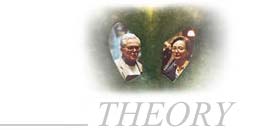INTRODUCTION
Extracted from the notice and the foreword of the book 'Rectoversion,
the exit'
Notice
The term 'Rectoversion' is a neologism created by Michel De Caso
to name the artistic operation that he was led to in 1991. 'Rectoversion'
concept was the subject of an official declaration with the National
Institute of Patent Rights.
Foreword
This book refers to texts written between 1985 and 2000. They deal
with the new relationship shared by the front (recto) and
back (verso) generated by 'rectoversion' and highlight the
privileged role played by the front to the detriment of the back.
Based on a criticism of this dualistic role, a new definition of
these two concepts is proposed.
The linguistic origin of the terms 'recto' and 'verso'
and their modern meaning which dates from the XVII century, will
be studied and we will illustrate how everything that was associated
with the back (verso) was considerably belittled; we will
analyze to what extent attitude known as rectilinear was privileged
at a time when the invention of perspective and the exclusive use
by painters of canvas on a stretcher were essential in generating
a thought process which has since been overtaken by the artistic
changes of the XX century.
The contemporary period would be waiting for words or expressions
capable of expressing the new ways of seeing and understanding.
We did not find in the existing terms any which can name our original
'plastic' operation in a satisfactory way. Also, we had to create
a neologism adapted to it, namely the term 'rectoversion' which
literally means the setting in rotation of the front (recto).
After intensive pictorial research for about fifteen years during
which we carried out many experiments from minimalism to expressionism
not forgetting painting-sculptures and other relief-paintings of
diverted objects, we were led to 'rectoversé' painting.
From many points of view, this offers a true two-dimensional exit.
'Rectoversion' itself consists of painting the two flat surfaces
of a base which has been percied with holes in different places.
The strict two dimensional aspect confers a traditional pictorial
filiation to it. However, it could not be updated until the end
of the XX century since it is part of the continuity of the history
of art and does not reject the contribution of modern and contemporary
painting.
The base of a 'rectoversé' painting is generally rigid
but the 'plastic rectoversion' operation can also be achieved on
a simple sheet of paper to paint, for example, a watercolour or
a 'rectoversé' pastel. Each painter expresses himself according
to his own style. One may paint a 'rectoversé' painting
of a rather realistic style while another may offer expressionnist
tone.
This does not prevent 'Rectoversion' from proposing philosophical
prolongations and in particular metaphysical prolongations. Its
initial physical character is carried away by the questions that
it evokes.
|

